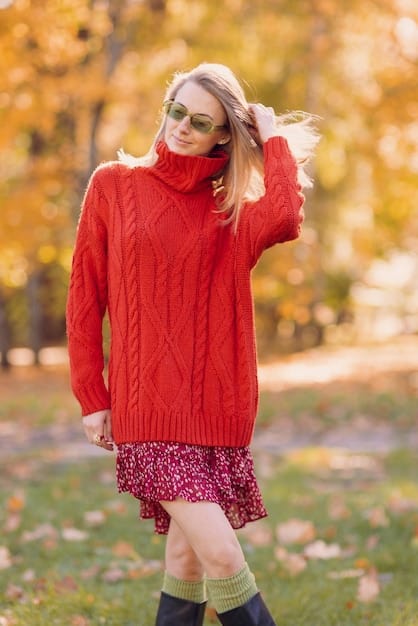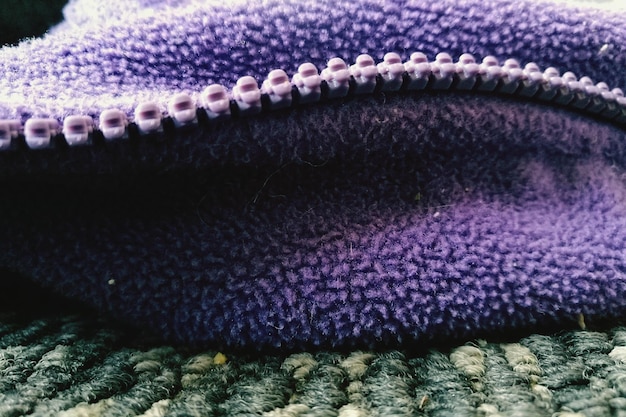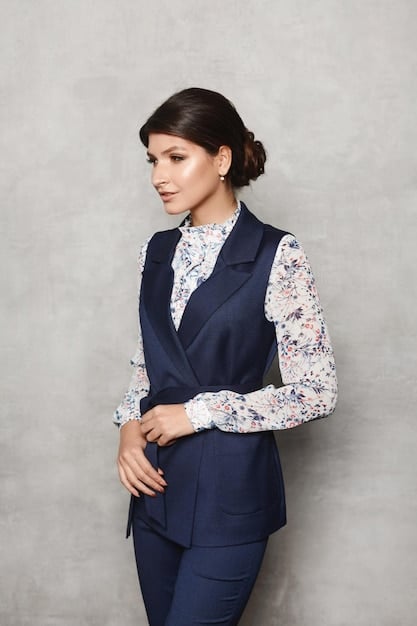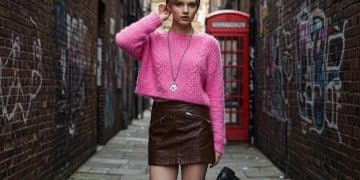The Art of Layering: A Comprehensive Guide for All Seasons

Mastering the art of layering involves strategically combining clothing items to create versatile, stylish outfits suitable for any season or occasion, enhancing both comfort and fashion.
The Art of Layering: Mastering the Technique for All Seasons and Occasions is a skill that every fashion enthusiast should possess. It’s not just about piling on clothes; it’s about creating a harmonious and functional outfit that adapts to changing temperatures and enhances your personal style. Let’s delve into the secrets of layering.
Understanding the Basics of Layering
Layering is more than just throwing on extra clothes when it’s cold. It’s a thoughtful process of combining different pieces to achieve both warmth and style. Knowing the fundamental principles can transform your wardrobe and make dressing for unpredictable weather a breeze.
The Importance of Fabric Choice
Selecting the right fabrics is crucial for effective layering. Breathable and moisture-wicking materials will keep you comfortable throughout the day, preventing overheating and sweat buildup.
- Base Layer: Opt for fabrics like merino wool, silk, or synthetic blends that wick away moisture and provide a comfortable foundation.
- Mid Layer: Choose insulating materials like fleece, down, or wool to trap heat and provide warmth.
- Outer Layer: Select water-resistant and windproof fabrics like Gore-Tex or treated nylon to protect against the elements.
The Layering System: Base, Mid, and Outer
The layering system typically consists of three main layers: a base layer, a mid-layer, and an outer layer. Each layer serves a specific purpose, working together to regulate body temperature and provide protection from the elements.
- Base Layer: Sits closest to your skin, wicking away moisture and keeping you dry.
- Mid Layer: Provides insulation, trapping heat and keeping you warm.
- Outer Layer: Protects against wind, rain, and snow, shielding you from the elements.

Understanding these basics ensures that your layered outfits are not only stylish but also practical and comfortable, allowing you to adapt to various weather conditions without sacrificing your personal flair.
Layering for Different Seasons
The art of layering isn’t confined to winter; it’s a year-round strategy for staying comfortable and stylish. Adjusting your layering techniques for each season can help you navigate fluctuating temperatures and express your personal style, no matter the weather.
Spring Layering: Light and Versatile
Spring weather can be unpredictable, with warm days and cool evenings. Light and versatile layers are essential for navigating this transitional season.
- Light Jacket: A denim jacket, bomber jacket, or trench coat is perfect for adding a layer of warmth without being too bulky.
- Cardigan or Sweater: A lightweight cardigan or sweater can be easily added or removed as the temperature changes.
- Scarves: A stylish scarf can add both warmth and visual interest to your outfit.
Summer Layering: Sun Protection and Style
Even in summer, layering can be useful for sun protection and adding a stylish touch to your outfit. Focus on lightweight, breathable fabrics that keep you cool and comfortable.
- Light Shirt: A linen or cotton button-down shirt can be worn over a tank top or dress for sun protection and a touch of elegance.
- Kimono or Cover-Up: A lightweight kimono or cover-up is perfect for adding a stylish layer at the beach or pool.
- Hats: A wide-brimmed hat can protect your face and neck from the sun while adding a fashionable element to your look.
Autumn Layering: Embracing Warmth and Texture
Autumn is the perfect season for embracing warm and textured layers. Rich colors, cozy fabrics, and stylish accessories can create comfortable and chic outfits.
- Sweaters: Chunky knit sweaters, turtlenecks, and cardigans are essential for staying warm and stylish in the fall.
- Vests: A quilted vest, puffer vest, or faux fur vest can add an extra layer of warmth and texture to your outfit.
- Scarves and Wraps: Oversized scarves and wraps are perfect for adding warmth and visual interest to your look.
By adapting your layering techniques to each season, you can stay comfortable and stylish year-round, making the most of your wardrobe and expressing your personal flair.
Layering for Different Occasions
Layering isn’t just for practical purposes; it’s also a powerful tool for creating stylish and appropriate outfits for various occasions. Whether you’re heading to the office, going out for a casual weekend, or attending a special event, layering can elevate your look and showcase your personal style.
Casual Outings: Comfort and Style
For casual outings, focus on comfortable and relaxed layers that reflect your personal style. Mix and match different textures and patterns to create interesting and effortless looks.
- T-Shirt and Flannel: A classic combination of a basic t-shirt layered under a flannel shirt is perfect for a laid-back weekend look.
- Hoodie and Jacket: Layering a hoodie under a denim jacket or bomber jacket adds warmth and a casual vibe to your outfit.
- Leggings and Oversized Sweater: A comfortable and stylish combination of leggings layered under an oversized sweater is perfect for running errands or lounging at home.
Professional Settings: Sophistication and Polish
In professional settings, layering can add sophistication and polish to your look. Choose tailored pieces in neutral colors and classic silhouettes to create a professional and elegant ensemble.

- Blouse and Blazer: A classic combination of a blouse layered under a blazer is perfect for adding a touch of professionalism to your outfit.
- Sweater and Button-Down: Layering a sweater over a button-down shirt adds warmth and sophistication to your look.
- Cardigan and Dress: A cardigan layered over a sheath dress is perfect for adding a layer of warmth and style to your professional wardrobe.
Special Events: Elegance and Glamour
For special events, layering can add elegance and glamour to your look. Choose luxurious fabrics, sophisticated silhouettes, and eye-catching accessories to create a memorable and stylish ensemble.
- Dress and Shawl: A beautiful dress layered with a luxurious shawl can add elegance and warmth to your special event outfit.
- Top and Embellished Jacket: Layering a simple top with an embellished jacket adds glamour and visual interest to your look.
- Skirt and Corset: A corset layered over the skirt can add structure and style to your look.
By tailoring your layering techniques to suit different occasions, you can create stylish and appropriate outfits that reflect your personal style and make a lasting impression.
Accessorizing Your Layered Outfits
Accessories play a crucial role in completing your layered outfits, adding personality, style, and functionality. Choosing the right accessories can elevate your look and enhance your overall aesthetic.
Scarves: Adding Warmth and Style
Scarves are a versatile accessory that can add warmth, color, and texture to your layered outfits. Experiment with different fabrics, patterns, and styles to create unique and eye-catching looks.
- Silk Scarves: Add a touch of elegance and sophistication to your outfit.
- Wool Scarves: Provide warmth and coziness in colder weather.
- Patterned Scarves: Add visual interest and personality to your look.
Hats: Functionality and Fashion
Hats are a practical and stylish accessory that can protect you from the elements and add a fashionable touch to your outfit. Choose a hat that complements your personal style and the overall aesthetic of your layered look.
- Beanies: Perfect for adding a casual and cozy vibe to your outfit.
- Fedora: Add a touch of sophistication and elegance to your look.
- Baseball Caps: Great for adding a sporty and relaxed vibe to your outfit.
Jewelry: Adding Sparkle and Personality
Jewelry can add sparkle, personality, and a touch of glamour to your layered outfits. Choose pieces that complement your personal style and enhance the overall aesthetic of your look.
By carefully selecting and incorporating accessories into your layered outfits, you can elevate your look and showcase your personal style, creating ensembles that are both functional and fashionable.
Common Layering Mistakes to Avoid
While layering is a fantastic way to create stylish and functional outfits, it’s easy to make mistakes that can lead to discomfort or a less-than-flattering appearance. Avoiding these common pitfalls will ensure that your layered looks are always on point.
Overdoing It: Too Many Layers
Adding too many layers can make you feel bulky and uncomfortable. Stick to a maximum of three or four layers to maintain comfort and mobility. Instead of piling on numerous thin layers, focus on selecting a few high-quality pieces that provide adequate warmth and protection.
Ignoring Fabric Compatibility
Choosing incompatible fabrics can lead to discomfort and an unflattering silhouette. Avoid combining fabrics that cling to each other or trap moisture. Opt for breathable and moisture-wicking materials that allow for airflow and prevent overheating.
Neglecting Proportion and Balance
Failing to consider proportion and balance can result in an awkward or unbalanced look. Pay attention to the length, volume, and shape of each layer to create a harmonious and flattering silhouette.
By avoiding these common layering mistakes, you can create stylish, comfortable, and flattering outfits that enhance your personal style and keep you prepared for any weather condition.
Maintaining Comfort and Style in Layered Outfits
The key to successful layering lies in maintaining both comfort and style. Balancing practicality with aesthetics ensures that your layered outfits not only look good but also feel great.
Prioritize Breathable Fabrics
Choosing breathable fabrics is essential for staying comfortable in layered outfits. Opt for materials like merino wool, cotton, and linen that allow air to circulate and prevent overheating. Avoid synthetic fabrics that trap moisture and can lead to discomfort.
Consider the Fit of Each Layer
Paying attention to the fit of each layer is crucial for creating a flattering and comfortable silhouette. Avoid wearing layers that are too tight or too loose, as they can restrict movement and create a bulky appearance. Opt for pieces that fit comfortably and allow for easy layering.
Experiment with Different Textures and Patterns
Layering provides an excellent opportunity to experiment with different textures and patterns, adding visual interest and personality to your outfits. Mix and match different fabrics, prints, and colors to create unique and eye-catching looks.
By prioritizing breathable fabrics, considering the fit of each layer, and experimenting with different textures and patterns, you can create layered outfits that are both comfortable and stylish, allowing you to look and feel your best in any situation.
| Key Point | Brief Description |
|---|---|
| 🧥 Base Layer Fabrics | Select merino wool or silk for moisture-wicking and comfort. |
| ☀️ Summer Layering | Use light shirts for sun protection and stylish cover-ups. |
| 🏢 Professional Layering | Combine blouses with blazers for a polished, professional look. |
| 🧣 Accessorizing | Use scarves and hats to add style and functionality. |
Frequently Asked Questions about Layering
▼
The best fabrics for a base layer include merino wool, silk, and synthetic blends. These materials are excellent at wicking away moisture, keeping you dry and comfortable throughout the day.
▼
Generally, three to four layers are sufficient for most situations. Overdoing it with too many layers can lead to discomfort and restrict movement. Focus on quality over quantity in your layering strategy.
▼
Yes, but with caution. Mixing patterns and textures can create a stylish look, but it’s important to balance them well. Start with a neutral base and add one or two patterned or textured pieces to avoid overwhelming the outfit.
▼
For formal events, opt for elegant and sophisticated layers such as a dress with a shawl or a blouse with a tailored blazer. Choose luxurious fabrics and complementary colors to maintain a polished appearance.
▼
To avoid overheating, prioritize breathable and moisture-wicking fabrics. Ensure that your base layer efficiently removes moisture, and avoid synthetic materials that can trap heat. Also, be prepared to remove layers as needed to regulate your body temperature.
Conclusion
Mastering the art of layering is a valuable skill that enhances both your style and comfort in various weather conditions and occasions. By understanding the basics, choosing appropriate fabrics, and accessorizing thoughtfully, you can create versatile and fashionable outfits. Avoid common mistakes, and always prioritize comfort and balance to make the most of your layered looks.





